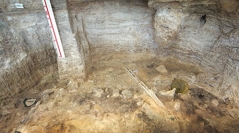

 Comptes Rendus Palevol
15 (5) - Pages 581-594
Comptes Rendus Palevol
15 (5) - Pages 581-594Understanding the changes in the technological organization of prehistoric hunter–gatherers is important to research into hominin foraging activities. During the Middle Paleolithic, the coexistence or the replacement between Levallois and discoid technologies has frequently been recorded, but there is still no clear understanding of the reasons for their alternating and fragmented use in the archaeological record. This paper aims to contribute with new data to the current debate, by exploring the chert assemblages from levels O and M of the Abric Romaní rock-shelter. The results reveal that the change from Levallois in level O to discoid in level M is accompanied by the use of different axes of mobility, a reduction in the foraging radius and a more careful management of raw materials. A cross comparison with other archaeological evidences indicates the general pattern in the Northeast of the Iberian Peninsula during the late Middle Paleolithic, in which the use of Levallois technology is associated with chert and high mobility patterns whereas discoid technology is more closely linked to the use of local raw materials and a lower degree of mobility. The modifications to the mountainous environments and to the distribution of preferred prey animals may have influenced the Neanderthals’ mobility patterns and contributed to modifying their technical behaviours in order to obtain better foraging incomes.
Middle Paleolithic, Neanderthal mobility, Levallois technology, Discoid technology, Technological change